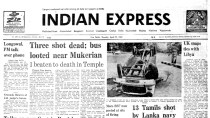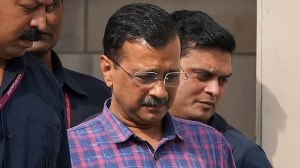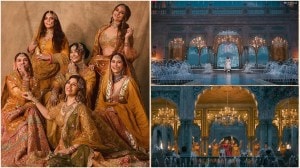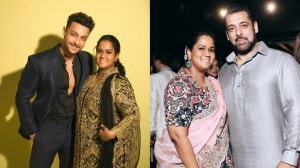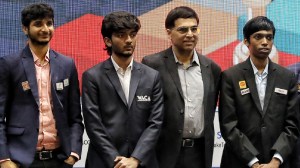- India
- International
Modi has brought into practice a style of one-way communication: Giving out messages
Modi probably believes that he doesn’t need the media because his power derives from the people. He forgets that without the prolonged love affair that the media had with him, his image could not have been built in the way it was between 2013 and 2018.
 Prime Minister Narendra Modi listens as BJP president Amit Shah addresses a press conference at the party headquarters in New Delhi, India, Friday, May 17, 2019. (AP Photo: Manish Swarup)
Prime Minister Narendra Modi listens as BJP president Amit Shah addresses a press conference at the party headquarters in New Delhi, India, Friday, May 17, 2019. (AP Photo: Manish Swarup)
Last Friday’s dud press conference by Narendra Modi-Amit Shah might be seen as yet more proof that the prime minister doesn’t face the media impromptu. But that episode and Modi’s unwillingness to be more accessible to the media is instructive for a very different reason. It has brought forward the issue of the relationship between political leaders and the public in a democracy.
During the past few weeks, it has been widely commented that the PM shies away from media interactions. He was being compared to Rahul Gandhi on this score. To rebut these charges, Modi began a well-orchestrated media exercise and since that was sure to give good TRPs, media houses lapped it up.
The non-political interview by Akshay Kumar was supposed to be a masterstroke. It could beat the model code of conduct and at the same time, ensure that the image of the leader was carefully projected. One is not sure how many viewers genuinely appreciated that interview — where Modi was ill at ease and the interviewer clueless.
All this while, a question kept cropping up — why not a routine, standard practice of interacting with media persons or holding a press conference? The grapevine has it that the PM probably wanted to avoid awkward questions. Critics said that Modi holds the media in contempt and therefore chooses to ignore them. Both might well be plausible explanations. It looks like the PM was being protected from the media while simultaneously using the media to put across the messages he wanted to communicate to his audience.
But there seems to be a larger issue here. More than fear or contempt (the two can be interconnected), it is a question of leadership style. Modi has brought into practice a style that consists of one-way communication: Giving out messages. He is a leader who does not like to enter into dialogue, doesn’t want an exchange with the media. He won’t brook hard questioning; soft probing, like Akshay Kumar’s, was admissible. Earlier, a demonstration of this genre of interview was given by Prasoon Joshi in a “reality show” performed abroad. But no real questioning. After all, there are not many leaders with the distinction of having left an interview mid-way.

Political leaders and the media have a relationship riddled with tension. Leaders get accustomed to deference. Media persons are often expected to stay within limits. Nevertheless, democracy has the potential of introducing a levelling effect whereby the leader gets the taste of political equality. Any journalist can hurl a tough and even personal or awkward question at the leader. Leaders in democracies have to take this in their stride.
They, of course, would make attempts to cultivate a friendly media; they would occasionally browbeat the media. But in spite of all this, media persons with even limited amounts of professionalism are often likely to prove difficult. Political leaders most often appreciate this fact of democratic life and live with it. This allows examination and public questioning of leaders — not just in India but across the globe.
Modi represents a section of political leaders who refuse to submit to such examination, who are unwilling to be tested. They prefer the pulpit. Naveen Patnaik is famous for his reclusive ways, Mayawati rarely allows herself to be grilled, Jayalalithaa wove an enigma around herself. They all have won and lost elections and have survived splits or defections from their parties. But they would still remain, as leaders, deeply uncomfortable with questioning by the commoners. The media can be only an instrument to build their image; they would not recognise that it is also the citizen’s tool for bridging the gap between the elite and non-elite.
Modi has taken this tendency to avoid a two-way traffic with the public to the level of an artful skill. He crafts messages for the public where he is the preacher — the giver. In public speeches, there are the crowds, appropriately excited, and Modi arrives with a set speech, a pre-planned punch line that would arouse response, and the rest would be done by the IT army and the Twitter public that is more loyal than the king. Mann ki Baat has been another instance. In it, again, he is the only messenger, there is no interaction.
But party politics and electoral competition are strange things. Despite the obvious creation of power hierarchies, they tend to also strive for political equality of sorts — where the non-powerful have the vicarious satisfaction of bringing the powerholders down from the pulpit. It seems that this campaign exposed this major limitation of Modi — his unwillingness to step down from the pulpit, even momentarily. And the poetic justice of this was that this limitation was drawn out by none other than the “Pappu” he had created.
Most public personalities, but more so politicians, adapt themselves to the ways of an intransigent media, whose excesses and tendency to peep into private lives are legendary (not so much in India, though). This submission of the elite to media scrutiny, with all its evils, needs to be seen as a culture of democracy compensating for the absence of citizen scrutiny. Politicians in democracies come to terms with this democratic culture — and that is why Trump is seen as an aberration.
The question that Modi’s extreme reluctance to face such media scrutiny raises is not limited to the persona of Modi, his vanity or to his self-belief in being a new architect of the fate of India — a bhagyavidhata. Modi has been in the upper echelons of the power hierarchy for a fairly long time. Yet, he has steadfastly refused to imbibe the primary test of democratic politics — allowing tough questions and trying to answer them. He probably believes that he doesn’t need the media to project his image because his power derives from the people. He forgets that without the prolonged love affair that the media had with him, his image could not have been built in the way it was between 2013 and 2018.
But the issue is not confined to Modi’s dependence on the media or his autonomy from it; Modi’s awkward response to democracy’s requirement of willing submission to public scrutiny draws attention to the larger issue: If leaders were to avoid media scrutiny, what does that tell us about their commitment to the democratic culture of political equality?
This article first appeared in the print edition on May 21, 2019 under the title ‘Politics from the pulpit’. The writer was professor of political science and is based at Pune.
EXPRESS OPINION
More Explained
Apr 23: Latest News
- 01
- 02
- 03
- 04
- 05











